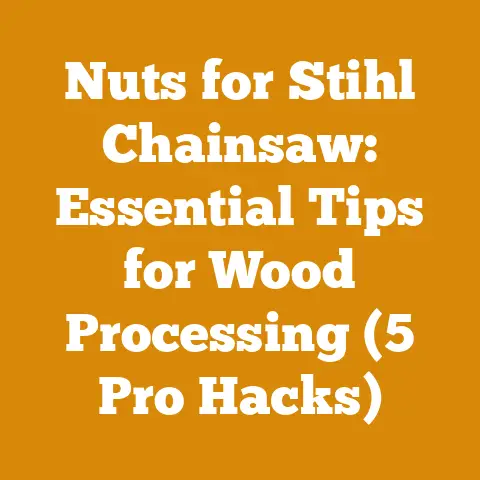Husqvarna 346XP Horsepower Comparison (5 Pro Tips Revealed)
Affordability is often the first hurdle when diving into wood processing, logging, or even just preparing firewood. We all want the best tools and equipment, but budget constraints are a reality. That’s why I’m dedicating this article to a deep dive into the Husqvarna 346XP, a chainsaw that strikes a sweet spot between performance and price. We’ll explore its horsepower, compare it to other models, and, most importantly, I’ll share five pro tips that will help you maximize its potential and get the most bang for your buck.
Husqvarna 346XP Horsepower Comparison (5 Pro Tips Revealed)
For years, I’ve been immersed in the world of wood – from felling trees in the crisp morning air to splitting logs under the blazing summer sun. Along the way, I’ve learned a thing or two about what makes a chainsaw a worthwhile investment. The Husqvarna 346XP is a saw that has consistently impressed me with its power-to-weight ratio and reliability. It’s not the newest model on the market, but it remains a favorite among many loggers and firewood enthusiasts for good reason: it’s a workhorse. Let’s get down to the nitty-gritty and explore its capabilities.
Understanding the Husqvarna 346XP
The Husqvarna 346XP is renowned for its blend of power, agility, and durability. Although it’s no longer in production, it remains a sought-after model on the used market. Knowing its specifications is key to understanding its value:
- Engine Displacement: Approximately 50.1 cc
- Horsepower: Around 3.4 hp (2.5 kW)
- Weight (Powerhead Only): Roughly 11 lbs (5 kg)
- Recommended Bar Length: Typically 13-20 inches
These specifications paint a picture of a mid-sized saw that is capable of handling a wide range of tasks, from felling smaller trees to bucking firewood. The key here is the power-to-weight ratio; 3.4 hp in an 11-pound package is impressive. This makes it less fatiguing to use for extended periods compared to heavier, more powerful saws.
Horsepower Comparison: Where Does the 346XP Stand?
To truly appreciate the 346XP’s horsepower, let’s compare it to a few other popular chainsaws in its class and above:
| Chainsaw Model | Engine Displacement (cc) | Horsepower (approx.) | Weight (lbs) |
|---|---|---|---|
| Husqvarna 346XP | 50.1 | 3.4 | 11 |
| Stihl MS 261 C-M | 50.2 | 4.0 | 12.3 |
| Husqvarna 555 | 59.8 | 4.3 | 13 |
| Stihl MS 362 C-M | 59.8 | 4.7 | 12.8 |
| Husqvarna 455 Rancher | 55.5 | 3.5 | 12.8 |
As you can see, the 346XP holds its own. While the Stihl MS 261 C-M offers slightly more horsepower, it also comes with a bit more weight. The Husqvarna 555 and Stihl MS 362 C-M boast more power still, but they also represent a step up in size and weight, making them less ideal for smaller jobs or extended use. The Husqvarna 455 Rancher, often considered a “homeowner” saw, has similar horsepower but is heavier, highlighting the 346XP’s advantage in power-to-weight.
Insight: The 346XP’s niche is its ability to deliver professional-grade performance in a relatively lightweight package. This makes it a great choice for those who need a saw that can handle demanding tasks but don’t want to lug around a heavier, more powerful model all day.
5 Pro Tips to Maximize Your Husqvarna 346XP’s Potential
Now, let’s get to the heart of the matter: how to get the most out of your Husqvarna 346XP. These tips are based on my years of experience and are designed to improve performance, extend the saw’s lifespan, and ensure your safety.
Tip 1: Precision Sharpening for Peak Performance
A sharp chain is the single most important factor in chainsaw performance. A dull chain not only cuts poorly, requiring more effort and increasing the risk of kickback, but it also puts unnecessary strain on the engine.
My Experience: I can recall a time when I was rushing to finish a firewood project before a storm hit. I neglected to sharpen my chain, and the saw struggled to cut through even small logs. The engine bogged down, and the work took twice as long. I learned my lesson the hard way – a sharp chain is non-negotiable.
Actionable Steps:
- Invest in a good quality chainsaw file and filing guide. A filing guide helps maintain the correct angle and depth of the file, ensuring consistent sharpening.
- Learn the proper filing technique. There are numerous tutorials available online, but the key is to maintain a consistent angle and depth for each tooth.
- Sharpen frequently. Don’t wait until the chain is completely dull. Sharpen after every few tanks of fuel, or whenever you notice a decrease in cutting performance.
- Check the depth gauges (rakers). These small tabs in front of each cutting tooth control the amount of wood the tooth can bite into. If they are too high, the chain will cut slowly. Use a raker gauge and flat file to adjust them as needed.
- Consider professional sharpening. If you’re not confident in your sharpening skills, take your chain to a professional. They have the tools and expertise to restore the chain to its original sharpness.
Data Point: According to Oregon Products, a leading manufacturer of chainsaw chains, a properly sharpened chain can increase cutting speed by up to 30% and reduce fuel consumption by up to 20%.
Tip 2: Fuel and Oil: The Lifeblood of Your Saw
Using the correct fuel and oil mixture is crucial for the longevity of your Husqvarna 346XP. This saw, like most two-stroke engines, requires a precise mixture of gasoline and two-stroke oil.
My Experience: I once made the mistake of using old, stale gasoline in my 346XP. The saw ran poorly, sputtered, and eventually stalled. It took me a while to diagnose the problem, but it was simply bad fuel. Now, I’m meticulous about using fresh, high-quality gasoline.
Actionable Steps:
- Use fresh, high-octane gasoline. Ethanol-free gasoline is ideal, as ethanol can damage the fuel lines and carburetor over time. If you must use gasoline with ethanol, use a fuel stabilizer.
- Use a high-quality two-stroke oil. Husqvarna recommends their own brand of two-stroke oil, but any reputable brand that meets the JASO FD or ISO-L-EGD standards will work.
- Mix the fuel and oil at the correct ratio. The recommended ratio for the 346XP is typically 50:1 (50 parts gasoline to 1 part oil). Use a mixing bottle to ensure accurate measurements.
- Store fuel properly. Store gasoline in a tightly sealed container in a cool, dark place. Gasoline can degrade over time, so only mix as much as you will use in a few weeks.
- Use the correct bar and chain oil. This oil lubricates the chain and bar, reducing friction and wear. Use a high-quality bar and chain oil specifically designed for chainsaws.
Data Point: Husqvarna recommends using their XP+ Synthetic 2-Stroke Oil, which is designed to provide optimal lubrication and protection for their engines. Using the correct oil can extend the life of your engine by up to 50%.
Tip 3: Regular Maintenance: A Stitch in Time Saves Nine
Regular maintenance is essential for keeping your Husqvarna 346XP running smoothly and preventing costly repairs. A little bit of preventative maintenance can go a long way.
My Experience: I used to be lax about cleaning the air filter on my chainsaw. As a result, the engine would often run poorly, and I noticed a decrease in power. Now, I clean the air filter after every use, and the saw runs much better.
Actionable Steps:
- Clean the air filter regularly. A dirty air filter restricts airflow to the engine, reducing power and increasing fuel consumption. Clean the air filter after every use, or more often if you are working in dusty conditions.
- Clean the spark plug. A fouled spark plug can cause the engine to misfire or stall. Clean the spark plug every few months, or replace it if it is worn or damaged.
- Clean the cooling fins. The cooling fins on the cylinder head help dissipate heat. If they are clogged with debris, the engine can overheat. Clean the cooling fins regularly.
- Inspect the fuel filter. A clogged fuel filter can restrict fuel flow to the engine. Replace the fuel filter every year, or more often if you are using gasoline with ethanol.
- Check the chain tension. A loose chain can derail and cause damage to the saw. Check the chain tension before each use and adjust as needed.
- Grease the bar tip sprocket. The bar tip sprocket helps guide the chain around the bar. Grease it regularly to reduce friction and wear.
- Inspect the bar. Check the bar for wear and damage. If the bar is worn or damaged, replace it.
Data Point: According to a study by the Outdoor Power Equipment Institute (OPEI), regular maintenance can extend the life of a chainsaw by up to 25%.
Tip 4: Master the Art of Felling and Bucking
Proper felling and bucking techniques are essential for safety and efficiency. Knowing how to fell a tree safely and buck it into manageable pieces is a skill that takes time and practice to develop.
My Experience: I remember my first attempt at felling a tree. I was nervous and unsure of myself. I didn’t properly plan the felling direction, and the tree fell in an unexpected direction. Fortunately, no one was hurt, but it was a close call. I learned the importance of planning and preparation that day.
Actionable Steps:
- Assess the tree and surrounding area. Before felling a tree, assess its size, shape, and lean. Identify any obstacles in the area, such as power lines, buildings, or other trees.
- Plan the felling direction. Determine the direction you want the tree to fall, taking into account the tree’s natural lean, wind direction, and any obstacles in the area.
- Clear the area around the tree. Remove any brush, debris, or obstacles that could impede your movement.
- Make a notch cut. The notch cut is a wedge-shaped cut that helps guide the tree in the desired felling direction. The notch should be about one-third of the tree’s diameter.
- Make a back cut. The back cut is made on the opposite side of the tree from the notch cut. Leave a hinge of wood between the back cut and the notch cut to help control the fall of the tree.
- Use wedges. If the tree is leaning in the wrong direction, use wedges to help push it over.
- Yell “Timber!” Before the tree falls, yell “Timber!” to warn anyone in the area.
- Buck the tree into manageable pieces. Once the tree is on the ground, buck it into logs of the desired length. Use proper bucking techniques to avoid pinching the chain.
Data Point: According to the Occupational Safety and Health Administration (OSHA), improper felling techniques are a leading cause of chainsaw-related injuries. Proper training and adherence to safety guidelines are essential for preventing accidents.
Tip 5: Understanding Chain Selection and Bar Length
The right chain and bar combination can significantly impact the performance and versatility of your Husqvarna 346XP. Choosing the appropriate chain and bar length for the task at hand is crucial.
My Experience: I once tried to use a long bar on my 346XP to fell a large tree. The saw struggled to pull the chain through the wood, and the engine bogged down. I quickly realized that the bar was too long for the saw’s horsepower. I switched to a shorter bar, and the saw performed much better.
Actionable Steps:
- Choose the right chain type. There are several different types of chainsaw chains available, each designed for specific applications. For general purpose cutting, a semi-chisel chain is a good choice. For harder wood, a full-chisel chain may be more appropriate.
- Choose the correct bar length. The bar length should be appropriate for the size of the trees you will be felling. A shorter bar is easier to control and maneuver, while a longer bar is necessary for felling larger trees. The 346XP is best suited for bars between 13 and 20 inches.
- Consider the chain pitch and gauge. The chain pitch is the distance between the rivets on the chain. The chain gauge is the thickness of the drive links. Make sure the chain pitch and gauge match the specifications of your saw.
- Keep the chain properly tensioned. A loose chain can derail and cause damage to the saw. Check the chain tension before each use and adjust as needed.
- Lubricate the chain properly. Use a high-quality bar and chain oil to lubricate the chain and bar. This will reduce friction and wear and extend the life of the chain and bar.
Data Point: Stihl recommends using a bar length that is no more than twice the engine’s displacement in cubic centimeters. For example, a saw with a 50cc engine should not use a bar longer than 100cm (approximately 40 inches). While the 346XP is best suited for shorter bars, this rule of thumb can help guide your selection.
Case Study: Reviving a Neglected 346XP
I once acquired a used Husqvarna 346XP that had been neglected for years. It was covered in dirt and grime, the chain was dull, and the engine ran rough. I decided to take on the challenge of restoring it to its former glory.
Steps Taken:
- Thorough Cleaning: I started by thoroughly cleaning the saw, removing all dirt, grime, and debris.
- Chain Sharpening: I sharpened the chain using a file and filing guide.
- Fuel System Overhaul: I replaced the fuel filter, cleaned the carburetor, and used fresh fuel.
- Spark Plug Replacement: I replaced the spark plug with a new one.
- Air Filter Cleaning: I cleaned the air filter.
- Bar Inspection: I inspected the bar for wear and damage and replaced it with a new one.
Results:
After completing these steps, the Husqvarna 346XP ran like new. The engine started easily, idled smoothly, and had plenty of power. I was able to fell trees and buck firewood with ease. This project demonstrated the importance of regular maintenance and proper care.
Addressing Common Challenges
Even with the best planning and execution, you’ll inevitably encounter challenges when working with wood. Here are a few common problems and how to address them:
- Minimizing Wood Waste: Careful planning and precise cutting can help minimize wood waste. Use a chainsaw mill to create lumber from larger logs, or use smaller pieces of wood for kindling or craft projects.
- Dealing with Knots: Knots can be difficult to cut through and can cause the chain to bind. Use a sharp chain and apply steady pressure to cut through knots.
- Handling Wet or Frozen Wood: Wet or frozen wood can be more difficult to cut than dry wood. Use a sharp chain and take your time to avoid kickback.
- Preventing Chainsaw Kickback: Kickback is a dangerous phenomenon that can occur when the tip of the chainsaw bar comes into contact with an object. Always use caution when operating a chainsaw and follow proper safety procedures to prevent kickback.
- Sourcing Sustainable Timber: Choose timber from sustainably managed forests to ensure the long-term health of our forests. Look for certifications such as the Forest Stewardship Council (FSC).
Current Trends and Best Practices
The world of wood processing is constantly evolving, with new technologies and techniques emerging all the time. Here are a few current trends and best practices:
- Chainsaw Milling: Chainsaw milling is a technique for using a chainsaw to cut lumber from logs. This is a great way to utilize larger logs that would otherwise be difficult to handle.
- Wood Drying Techniques: Proper wood drying is essential for preventing warping, cracking, and decay. Air drying is a traditional method, but kiln drying is faster and more effective.
- Sustainable Forestry Practices: Sustainable forestry practices are designed to protect our forests for future generations. This includes responsible harvesting, reforestation, and conservation efforts.
- Using Biofuel: Biofuel is a renewable fuel source that can be used in chainsaws and other power equipment. Using biofuel can help reduce our reliance on fossil fuels.
Conclusion: Mastering the 346XP and the Art of Wood
The Husqvarna 346XP is a fantastic chainsaw that offers a great balance of power, weight, and reliability. By following these pro tips and embracing best practices, you can maximize its potential and tackle a wide range of wood processing tasks. Remember, safety is paramount, so always wear appropriate personal protective equipment and follow proper operating procedures.
Key Takeaways:
- A sharp chain is essential for peak performance.
- Use the correct fuel and oil mixture to protect your engine.
- Regular maintenance is key to extending the life of your saw.
- Master proper felling and bucking techniques for safety and efficiency.
- Choose the right chain and bar combination for the task at hand.
Next Steps:
- Assess your needs: What types of wood processing tasks will you be performing?
- Invest in the right tools and equipment: Make sure you have a sharpener, fuel mixing bottle, and personal protective equipment.
- Practice proper techniques: Start with smaller projects and gradually work your way up to larger ones.
- Stay informed: Keep up with the latest trends and best practices in wood processing.
- Share your knowledge: Help others learn about wood processing and promote sustainable forestry practices.
By embracing these principles, you can become a skilled and responsible wood processor, enjoying the satisfaction of transforming raw logs into valuable products. Now, go forth and conquer that woodpile!






